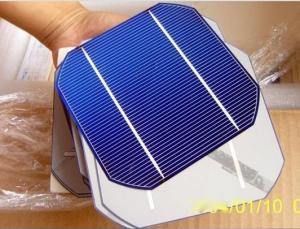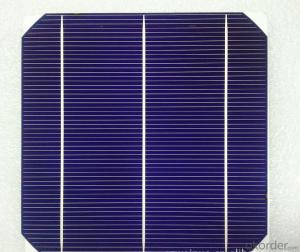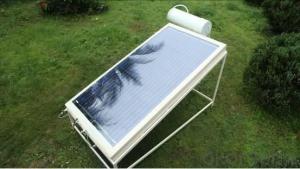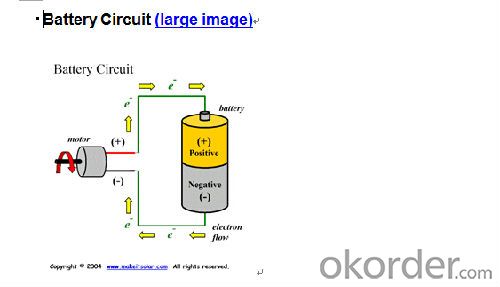Solar Cells With High Efficiecy with Discount
- Loading Port:
- Shanghai
- Payment Terms:
- TT or LC
- Min Order Qty:
- 500 pc
- Supply Capability:
- 20000 pc/month
OKorder Service Pledge
OKorder Financial Service
You Might Also Like
| Size: | 156*156±0.5mm | Max. Power: | 3.99w | Product: | damaged solar cells |
| Pmp: | 3.99w | Vmp: | 0.516v | Imp: | 7.731A |
| Voc: | 0.621v | Isc: | 8.262A | Efficiency: | 16.25-16.50% |
| Thickness: | 190±20um | Format: | 156*156±0.5mm | FF: | 77.77% |
| Packaging & Delivery | |
| Packaging Detail: | Original Package, 100pcs in one boxes, 10boxes in one carton |
| Delivery Detail: | 1~2days |
| Specifications | |
| damaged solar cells | |
| solar cells in stock with immediate delivery with big quantity, all range cells avaiable, poly | |
Manufacturer
1,Components,ultra-white Executed tempered glass+PVB+cell+PVB+tempered glass
Glass+PVB+Cell+PVB+Glass
2,Components with ultra-white Executed tempered glass+PVB+cell+PVB+tempered glass+of PVB+tempered glass
Glass+PVB+Cell+PVB+Glass+PVB+Glass
Quality and Safety
1.Rigorous quality control meeting the highest international standards
2.High-transmissivity low-iron tempered glass, strong aluminium frame
3.Using UV-resistant silicon
4.ISO 9001:2008 and ISO 14001:2004
5.IEC61215, IEC61730, Safety Class in conformity to CE
Features
1.High conversion efficiencies resulting in superior power output performance.
2.Outstanding power output even in low light or high temperature conditions
3.Optimized design for ease of soldering and lamination
4.Long-term stability,reliability and performance
Warranties
1.10 years limited product warranty
2.15 years at 90% of the minimal rated power output
3.25 years at 80% of the minimal rated power output
Format: 156mm x 156mm
Thickness: 190um+-20um
Front(-): 1.7mm bus bars(silver),blue anti-reflecting coating(silicon nirtride)
back(+): 3mm wide soldering pads(silver) back surface field(aluminium)
| Size | 156mm x156mm ±0.5mm | |||||
| Thickness | 190um ± 20um | |||||
| Front surface(-) | 1.7mm bus bars(silver), blue anti-reflecting coating(Silicon nitride) | |||||
| Back surface (+) | 3mm wide soldering pads(silver) back surface field(Aluminum) | |||||
| TkVoltage | -0.351%/K | |||||
| TkCurrent | +0.035%/K | |||||
| TkPower | -0.47%/K | |||||
| Efficiency(%) | Pmp(W) | Vmp(V) | Imp(A) | Voc(V) | Isc(A) | FF(%) |
| 16.25-16.50 | 3.99 | 0.516 | 7.731 | 0.621 | 8.262 | 77.77 |
| 16.00-16.25 | 3.92 | 0.512 | 7.66 | 0.616 | 8.195 | 77.68 |
| 15.75-16.00 | 3.86 | 0.509 | 7.584 | 0.613 | 8.135 | 77.43 |
| 15.50-15.75 | 3.8 | 0.505 | 7.525 | 0.611 | 8.08 | 77.04 |
| 15.25-15.50 | 3.74 | 0.502 | 7.458 | 0.609 | 8.053 | 76.2 |
| 15.00-15.25 | 3.68 | 0.5 | 7.365 | 0.609 | 8.038 | 75.12 |
| 14.75-15.00 | 3.62 | 0.498 | 7.271 | 0.607 | 8.045 | 74.23 |
| 14.50-14.75 | 3.56 | 0.497 | 7.16 | 0.604 | 8.04 | 73.3 |
| 14.25-14.50 | 3.5 | 0.494 | 7.091 | 0.603 | 8.08 | 71.84 |
| 14.00-14.25 | 3.44 | 0.494 | 6.96 | 0.601 | 8.065 | 70.91 |
solar cell Pic. and drawing:

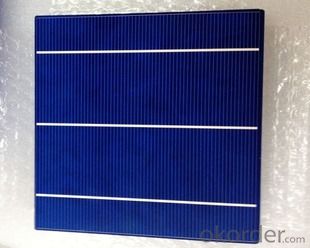
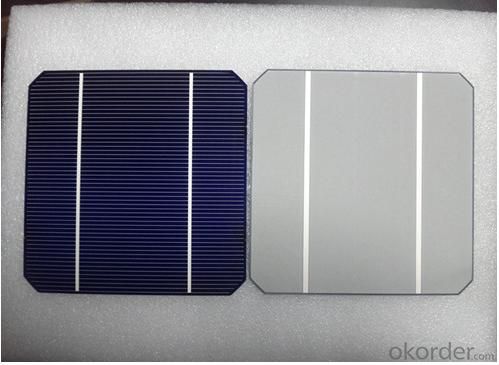
Benefits of Solar Power:
Now is a great time to go solar and harvest the power of the sun. Here is our top ten list of the benefits to installing solar power:
1, When installed, solar energy is free – no resources are consumed
2, Help to lessen our dependence on heavily polluting coal power stations
3, Fossil fuels can't last forever, future generations will appreciate the effort
4, You are gaining energy independence - add battery backup power for even greater energy security
5, The cost of electricity is only going to rise – insure against that rising cost
6, Quality solar power and water adds value and appeal to your home
7, Solar PV systems are easily upgraded in future - aim to make your house a net energy producer!
8, Solar panels offer a long lifetime of low maintenance service, maybe 30-40 years
9, Your friends will think you're great!
10, You'll feel great for doing your bit for the environment!
FAQ
1, What’s price per product ?
A: It’s depends on the quantity, delivery date and payment terms of the order. We can talk further about the detail price issue. Our products is high quality with lower price level.
2, How to make payment?
We accept T/T or L/C.
3, What is your lead time?
Generally 1-5 weeks depends on the order quantity and your specific requirements.
4, Can you do OEM for us?
Yes, we can.
5, How do you pack your products?
We have rich experience on how to pack the panels to make sure the safety on shipment when it arrives at the destination.
Some basic information about solar cell
Solar cells are devices which convert solar light energy directly into electricity and function by the photovoltaic effect. Photo- means light and -voltaic means electrical current or electricity (light-electricity). A solar cell provides direct current (DC) electricity that can be used to power DC motors and light bulbs among other things. Solar cells can even be used to charge rechargeable batteries so that electricity can be stored for later use when the sun is not available. The fully charged batteries are portable energy that can be used whenever and wherever they are needed.
Solar cells provide DC electricity similar to batteries however, batteries differ because they operate through a process known as an electrochemical reaction. This process will provide an electrical current (electro-) from a chemical reaction (-chemical) that occurs inside the battery. When you hook up a motor to the battery, also known as a load, the reaction begins and electrons flow as shown in the picture: "Battery Circuit". Direct current (DC electricity) is different from the alternating current (AC electricity) that is used to power the TV, refrigerator, and other appliances in your home however, DC can be converted to AC when needed.
Battery Circuit (large image)
Solar cells produce DC electricity from light. Sunlight contains packets of energy called photons that can be converted directly into electrical energy. You can’t see the photons but they hit the cell and produce free electrons that move through the wires and cause an electrical current as shown in the picture: "Solar Cell Circuit". The electrical current is the electricity that powers the motor. Although you can't see the photons you can see the light and you can assume that the amount of photons hitting your solar cell is related to the amount of light hitting your solar cell. A greater amount of light available means a greater amount of photons are hitting your solar cell and the more power you get from it.
Main technical parameters about solar cells
Cell Thickness
An optimum silicon solar cell with light trapping and very good surface passivation is about 100 µm thick. However, thickness between 200 and 500µm are typically used, partly for practical issues such as making and handling thin wafers, and partly for surface passivation reasons.
Doping of Base
A higher base doping leads to a higher Voc and lower resistance, but higher levels of doping result in damage to the crystal.
Reflection Control
(front surface typically textured)
The front surface is textured to increase the amount of light coupled into the cell.
Emitter Dopant
N-type silicon has a higher surface quality than p-type silicon so it is placed at the front of the cell where most of the light is absorbed. Thus the top of the cell is the negative terminal and the rear of the cell is the positive terminal.
Emitter Thickness
A large fraction of light is absorbed close to the front surface. By making the front layer very thin, a large fraction of the carriers generated by the incoming light are created within a diffusion length of the p-n junction.
Doping Level of Emitter
The front junction is doped to a level sufficient to conduct away the generated electricity without resistive loses. However, excessive levels of doping reduces the material's quality to the extent that carriers recombine before reaching the junction.
Grid Pattern.
The resistivity of silicon is too high to conduct away all the current generated, so a lower resistivity metal grid is placed on the surface to conduct away the current. The metal grid shades the cell from the incoming light so there is a compromise between light collection and resistance of the metal grid.
Rear Contact.
The rear contact is much less important than the front contact since it is much further away from the junction and does not need to be transparent. The design of the rear contact is becoming increasingly important as overall efficiency increases and the cells become thinner.
- Q:How do solar cells handle hail or other severe weather conditions?
- Solar cells are designed to withstand severe weather conditions, including hail. They are made with durable materials such as tempered glass or other shatter-resistant materials that can withstand impacts. Additionally, solar panels undergo rigorous testing to ensure their ability to withstand hailstorms and other harsh weather conditions.
- Q:Are solar cells recyclable?
- Yes, solar cells are recyclable. The majority of their components, such as silicon, glass, and aluminum, can be recycled and reused to manufacture new solar panels. This helps reduce waste and minimize the environmental impact of solar cell disposal.
- Q:Can solar cells be used to power satellites?
- Yes, solar cells can be used to power satellites. In fact, they are the primary source of power for most satellites in space. Solar cells convert sunlight into electricity, which is then used to power the various systems and instruments on board the satellite.
- Q:What is the payback period for solar cells?
- The payback period for solar cells refers to the time it takes for the cost of installing solar panels to be recouped through energy savings. It typically ranges from 5 to 15 years, depending on factors such as the initial cost of installation, electricity usage, and available incentives or tax credits.
- Q:Can solar cells be used in telecommunications?
- Yes, solar cells can be used in telecommunications. They can power various telecommunication devices such as cell phones, radio transmitters, satellites, and remote communication systems, especially in areas with limited access to electricity grids. Solar energy can be harnessed to charge batteries or directly power these devices, providing a reliable and sustainable source of energy for telecommunications.
- Q:What is the impact of solar cells on reducing dependence on foreign energy sources?
- Solar cells have a significant impact on reducing dependence on foreign energy sources as they harness the abundant and renewable power of the sun. By generating electricity locally, solar cells decrease the need for importing energy from foreign countries, promoting energy independence. This not only strengthens national security but also reduces the economic and political risks associated with relying on foreign energy supplies. Additionally, solar cells contribute to a more sustainable and environmentally friendly energy system, reducing carbon emissions and mitigating climate change.
- Q:Can solar cells be used in portable devices?
- Yes, solar cells can be used in portable devices. They can be integrated into the design of various portable devices, such as smartphones, tablets, and wearable technology, to convert sunlight into electrical energy and charge the device's batteries. This allows for increased convenience and independence from traditional power sources in outdoor or remote environments.
- Q:Can solar cells be used in hotels?
- Yes, solar cells can be used in hotels to generate renewable and clean energy. They can be installed on the roofs or other suitable areas of hotels to capture sunlight and convert it into electricity, reducing the reliance on traditional energy sources and lowering utility costs.
- Q:Can solar cells be used for powering security systems?
- Yes, solar cells can be used for powering security systems. Solar cells convert sunlight into electricity, which can be used to power various devices including security systems. This renewable energy source is reliable, cost-effective, and environmentally friendly, making it a suitable option for powering security systems in remote locations or areas with limited access to electricity grids.
- Q:How do solar cells perform in areas with high levels of salt spray?
- Solar cells generally perform well in areas with high levels of salt spray. The materials used in solar cells are designed to be resistant to corrosion and degradation caused by salt exposure. However, regular cleaning and maintenance may be required to ensure optimal performance and prevent any potential buildup of salt deposits on the surface of the solar panels.
1. Manufacturer Overview |
|
|---|---|
| Location | |
| Year Established | |
| Annual Output Value | |
| Main Markets | |
| Company Certifications | |
2. Manufacturer Certificates |
|
|---|---|
| a) Certification Name | |
| Range | |
| Reference | |
| Validity Period | |
3. Manufacturer Capability |
|
|---|---|
| a)Trade Capacity | |
| Nearest Port | |
| Export Percentage | |
| No.of Employees in Trade Department | |
| Language Spoken: | |
| b)Factory Information | |
| Factory Size: | |
| No. of Production Lines | |
| Contract Manufacturing | |
| Product Price Range | |
Send your message to us
Solar Cells With High Efficiecy with Discount
- Loading Port:
- Shanghai
- Payment Terms:
- TT or LC
- Min Order Qty:
- 500 pc
- Supply Capability:
- 20000 pc/month
OKorder Service Pledge
OKorder Financial Service
Similar products
New products
Hot products
Hot Searches
Related keywords
